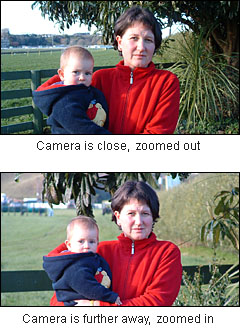Dolly Zoom

A dolly zoom is a cinematic technique in which the camera moves closer or further from the subject while simultaneously adjusting the zoom angle to keep the subject the same size in the frame. The effect is that the subject appears stationary while the background size changes (this is called perspective distortion).
In the first example pictured, the camera is positioned close to the subject and the lens is zoomed out. In the second shot, the camera is several metres further back and the lens is zoomed in.
The Effect
Dolly zooms create an unnatural effect — this is something your eyes would never normally see. Many people comment on the shot after seeing it for the first time, e.g. "That was weird" or "What just happened there?".
The exact effect depends on the direction of camera movement. If the camera moves closer, the background seems to grow and become dominant. If the camera moves further away, the foreground subject is emphasized and becomes dominant.
The effect is quite emotional and is often used to convey sudden realisation, reaction to a dramatic event, etc.
History
Invention of the dolly zoom is credited to cameraman Irmin Roberts. The technique was made famous by Alfred Hitchcock (Vertigo being the best-known example), and was used by Steven Spielberg in Jaws and ET. Many other directors have used the technique, which brings us to an important warning...
Warning
The dolly zoom is often over-used by junior directors. Many film critics see it as a cliché, so be very careful before you use this technique.
Other Terminology
The dolly zoom is also known as:
- Hitchcock zoom
- Vertigo zoom or vertigo effect
- Jaws shot
- Trombone shot
- Zolly or zido
- Telescoping
- Contra-zoom
- Reverse tracking
- Zoom in/dolly out (or vice versa)